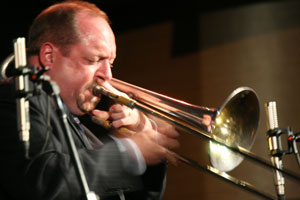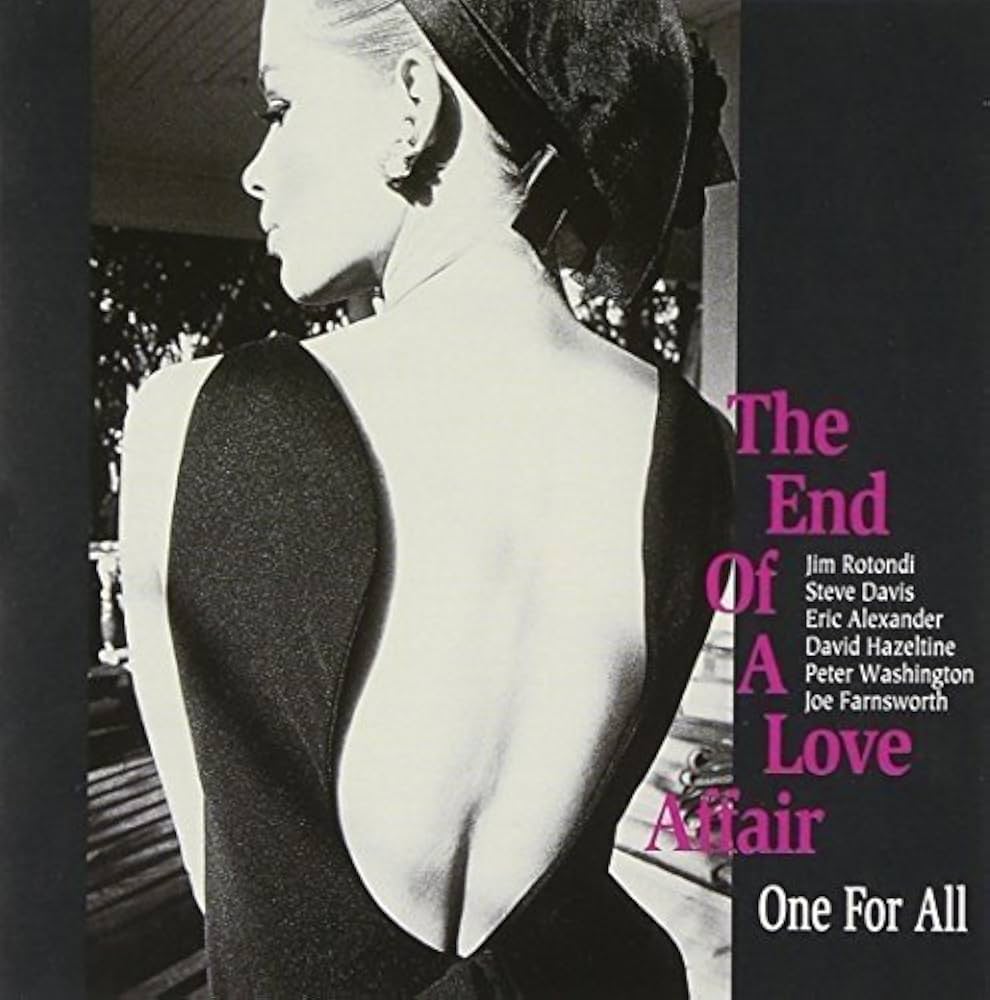Eyes Have It – Steve Davis
Minor blues with a bridge, in a shuffling Jazz Messengers vein. A Condensed Score and parts are available for the recorded sextet arrangement.
- Recording: One For All - The End Of A Love Affair
- Recorded on: March 12, 2001
- Label: Venus (TKCV 35095)
- Concert Key: G minor
- Vocal Range: , to
- Style: Swing (medium)
- Trumpet - Jim Rotondi
- Trombone - Steve Davis
- Tenor Sax - Eric Alexander
- Piano - David Hazeltine
- Bass - Peter Washington
- Drums - Joe Farnsworth
Video
- Description
- Historical Notes
- Solos
- Piano Corner
- Bass Corner
- Drum Corner
- Guitar Corner
- Inside & Beyond
- Minus You
Trombonist Steve Davis began his career as a member of Art Blakey's Jazz Messengers, and that band's influence is on display throughout The Eyes Have It. It's a shuffling minor-key blues with a bridge, full of slick hard-bop rhythms and with plenty of dynamic contrasts. The A section melody stays almost entirely in the blues scale, beginning with a long one-note crescendo and breaking into stop-and-start triplet phrases. The piano and bass have a rhythmic bass line throughout the A section, filling in the long notes of the melody. The bridge is 12 measures like the A section and features stop-time hits with piano solo fills for the first eight measures. The changes here imply C blues, but instead of a turnaround in the last four measures there is a rising series of II-V7s going back to G minor. On these last four measures of the bridge, the rhythm section plays staccato quarter notes—a "blues march."
On the solos, the rhythm section plays 4-feel for the A sections but keeps the stop-time and "blues march" in the bridge. The rhythm section sets up this song with one A section of the bass line as an intro. There is also a coda, in which the rhythm section vamps the first two measures of the same bass line leading to a final diminished chord. As the horns do not play in the coda, it is only shown in our piano and bass parts; on the horn parts the coda is indicated by the text "rhythm section only to end."
About the arrangement: A Condensed Score and horns, piano and bass parts are available for the recorded arrangement. Drummers should read the bass part as it includes the coda. Our 1st parts are also the lead sheets, which can be used if playing this song with only one melody instrument. The horns play unison or octaves on the A section and harmony on the bridge, with the 2nd and 3rd parts joining the rhythm section hits for the last four measures of the bridge. David Hazeltine's recorded voicings are included in the piano part.
On the solos, the rhythm section plays 4-feel for the A sections but keeps the stop-time and "blues march" in the bridge. The rhythm section sets up this song with one A section of the bass line as an intro. There is also a coda, in which the rhythm section vamps the first two measures of the same bass line leading to a final diminished chord. As the horns do not play in the coda, it is only shown in our piano and bass parts; on the horn parts the coda is indicated by the text "rhythm section only to end."
About the arrangement: A Condensed Score and horns, piano and bass parts are available for the recorded arrangement. Drummers should read the bass part as it includes the coda. Our 1st parts are also the lead sheets, which can be used if playing this song with only one melody instrument. The horns play unison or octaves on the A section and harmony on the bridge, with the 2nd and 3rd parts joining the rhythm section hits for the last four measures of the bridge. David Hazeltine's recorded voicings are included in the piano part.
"The End Of A Love Affair" was the first of One For All's four albums on the Venus label. Later in March 2001, Steve Davis played on two songs on "Destination Up", Jim Rotondi's first album as a leader for Sharp Nine, alongside fellow One For All members bassist Peter Washington and drummer Joe Farnsworth.
Steve Davis' first recordings, both in 1990, were the last two albums of Art Blakey's Jazz Messengers: "Chippin' In" and "One For All." The sextet One For All was of course named after the Blakey album.
Steve Davis' first recordings, both in 1990, were the last two albums of Art Blakey's Jazz Messengers: "Chippin' In" and "One For All." The sextet One For All was of course named after the Blakey album.
Related Songs
Email Send Eyes Have It to a friend
Send this page to a friend via email. Add your name or email in the first field. In the second, add one or more email addresses, separated by a comma.

Steve Davis
born on April 14, 1967
Steve Davis is widely regarded as one of today's leading improvisers on the trombone. His lyrical, hard-swinging style first gained him broad recognition during the 1990s while working with the bands of jazz legends Art Blakey, Jackie McLean, Chick Corea's Origin and the cooperative sextet, One For All. Steve also followed in his mentor Curtis Fuller's footsteps by joining saxophone legend Benny Golson and The New Jazztet in 2008. Read more...
There was a problem.
...

